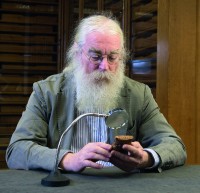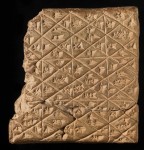 Dr. Irving Finkel, world-renowned cuneiform expert, Assistant Keeper of Mesopotamian tablets at the British Museum and author of the thoroughly delightful book The Ark Before Noah: Decoding the Story of the Flood, is bringing his enormous brain and limitless enthusiasm for ancient Mesopotamian history and culture to the United States. On April 1st (no, this is not a clever months-in-advance prank; I deserve neither such praise nor such censure), Dr. Finkel will be giving a lecture at the Getty Villa museum in Malibu. The topic will be the Ark before Noah: the ancient Babylonian Flood stories that predate the version in Genesis.
Dr. Irving Finkel, world-renowned cuneiform expert, Assistant Keeper of Mesopotamian tablets at the British Museum and author of the thoroughly delightful book The Ark Before Noah: Decoding the Story of the Flood, is bringing his enormous brain and limitless enthusiasm for ancient Mesopotamian history and culture to the United States. On April 1st (no, this is not a clever months-in-advance prank; I deserve neither such praise nor such censure), Dr. Finkel will be giving a lecture at the Getty Villa museum in Malibu. The topic will be the Ark before Noah: the ancient Babylonian Flood stories that predate the version in Genesis.
 Dr. Finkel’s translation of a previously unknown Babylonian clay tablet from around 1750 B.C. recounting the Akkadian version of the Flood myth starring Atra-Hasis as the Noah figure revealed a treasury of engineering details about the construction of the great ark found on none of the other surviving Atra-Hasis tablets. It was round, for one thing, and made of woven and coiled palm-fiber ropes slathered with bitumen. There was enough detail in the tablet to allow for an attempted recreation of the ark on a much reduced scale, of course. A wonderful documentary was made about the attempt.
Dr. Finkel’s translation of a previously unknown Babylonian clay tablet from around 1750 B.C. recounting the Akkadian version of the Flood myth starring Atra-Hasis as the Noah figure revealed a treasury of engineering details about the construction of the great ark found on none of the other surviving Atra-Hasis tablets. It was round, for one thing, and made of woven and coiled palm-fiber ropes slathered with bitumen. There was enough detail in the tablet to allow for an attempted recreation of the ark on a much reduced scale, of course. A wonderful documentary was made about the attempt.
In the lecture, Dr. Finkel will talk about the tablet and his translation and research. It will be held at 2:00 PM in the auditorium of the Getty Villa in Malibu. Tickets are free and can be booked by phone or on the Getty’s website. The auditorium opens at 1:30 and seating is first come, first served.
 April 1st is a Saturday. Make a weekend of it, because on Sunday, April 2nd, Dr. Finkel will be back at the Getty Villa being even cooler than he was the day before, if that’s possible. You see, in addition to being able to sight-read cuneiform and write grippingly about ancient tablet inscriptions, Dr. Finkel is also an expert on the Royal Game of Ur, a stone, shell and lapis lazuli board game from 2600 B.C. that was discovered in the Royal Cemetery of Ur in Iraq by archaeologist Sir Leonard Woolley during the 1926-1927 dig season. It is believed to be a race game where the aim is to beat your opponent to the finish line, like backgammon, which may be a descendant of the Royal Game and/or its older Egyptian cousin Senet.
April 1st is a Saturday. Make a weekend of it, because on Sunday, April 2nd, Dr. Finkel will be back at the Getty Villa being even cooler than he was the day before, if that’s possible. You see, in addition to being able to sight-read cuneiform and write grippingly about ancient tablet inscriptions, Dr. Finkel is also an expert on the Royal Game of Ur, a stone, shell and lapis lazuli board game from 2600 B.C. that was discovered in the Royal Cemetery of Ur in Iraq by archaeologist Sir Leonard Woolley during the 1926-1927 dig season. It is believed to be a race game where the aim is to beat your opponent to the finish line, like backgammon, which may be a descendant of the Royal Game and/or its older Egyptian cousin Senet.
 Much of what we know about how the game was played comes from, you guessed it, a cuneiform tablet also in the British Museum. This tablet was inscribed in 177-176 B.C. by Babylonian astronomer Itti-Marduk-balatu, who was kind enough to sign his work. By then the game was thousands of years old, and the way it was played had changed. It was also used for divining the future, which is why an astronomer would be an appropriate person to explain the whole system. The front of the tablet has a diagram explaining how to use the central squares to tell fortunes.
Much of what we know about how the game was played comes from, you guessed it, a cuneiform tablet also in the British Museum. This tablet was inscribed in 177-176 B.C. by Babylonian astronomer Itti-Marduk-balatu, who was kind enough to sign his work. By then the game was thousands of years old, and the way it was played had changed. It was also used for divining the future, which is why an astronomer would be an appropriate person to explain the whole system. The front of the tablet has a diagram explaining how to use the central squares to tell fortunes.
As curator of the British Museum’s enormous 130,000-piece clay tablet collection, Finkel has had opportunity to research Itti-Marduk-balatu’s instructional.
This extraordinary board game, played for a good three thousand years over half the ancient world with unceasing enjoyment, has bewitched Irving Finkel of the British Museum since boyhood. Tutankhamun of Egypt played it, as did Assyrian king Assurbanipal. Due to Finkel’s extensive research of an ancient cuneiform tablet containing original rules, we can see why the game endured. In this illustrated talk, he describes some of the remarkable discoveries and heart-thumping adventures of a lifetime’s fascination. Halfway through a magnum opus on the subject, he offers fascinating insight into board game history and the lives of the Assyrians. Be prepared to sit on no more than the edge of your seats.
I CAN’T BE ANY MORE EXCITED THAN THIS ALREADY, GETTY PEOPLE!
Or so I thought. Then I read this next bit in the press release.
Join Dr. Finkel either before or after the talk for a friendly tournament featuring the ancient game of Ur. Learn how Ur was played, compete against your friends and family, and make your own version of a game.
1:00-2:00 p.m. and 3:00-4:00 p.m.
Villa Education Studio/Court
This is a free, drop-in program.
Pardon me while I get a paper bag to hyperventilate into. This is so insanely cool. All you Californians, California-adjacents and California-bound must get to the Getty Villa the first weekend in April. Anyone who plays the Royal Game of Ur with Irving Finkel must report back and I will write you up like the superstars you are. (Get pictures!)